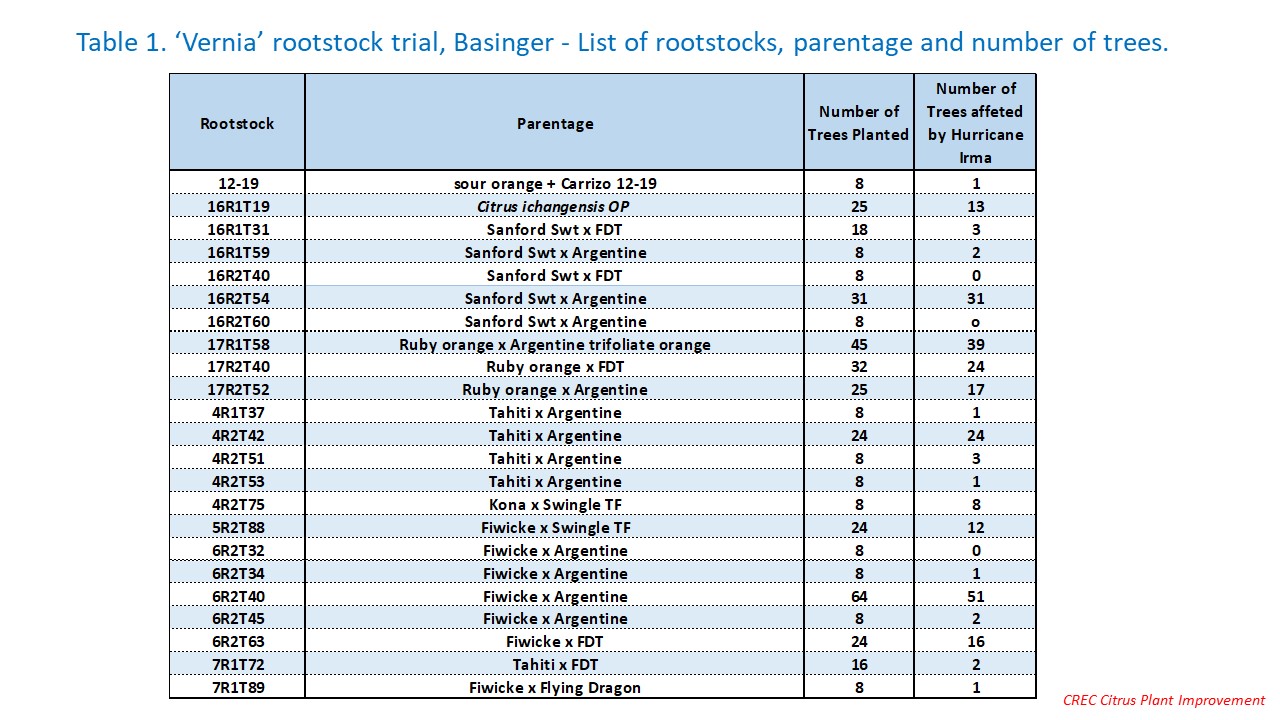‘Vernia’ Rootstock Trial, Basinger
Dr. Bill Castle – Dr. Fred Gmitter
Dr. Jude Grosser – Dr. Kim Bowman [USDA, Ft. Pierce]
November 1, 2021 - Revised
November 9, 2020 - Updated
December 7, 2018 - Posted
CREC/USDA Citrus Plant Improvement
‘Vernia’ Rootstock Trial, Basinger - Description
This trial with ‘Vernia’ scion was planted in a grove near Basinger, Highlands County. Planting commenced in 2006 and was completed in 2007. Because the block had different soils at each end, it was decided to plant two sub-trials, one at the east end [NE] and the other at the west end [SW] of the block. There were 14 rows [7 double-row beds] each at the NE and SW locations with 6 replicates of 8-tree linear plots with a break [no tree] at the end of each plot at NE and SW sites; thus, 48 trees on each rootstock at each location, NE and SW, or 96 trees total was the planting goal. The number of trees on each rootstock was not consistent, thus, the trees available on each rootstock were assigned to reps such that Replication 1 had the highest priority [most rootstocks of those available] and Rep 6 had the fewest rootstocks. There were 68 rootstocks, mostly citranges from the UF program, the C-series from California and various USDA hybrids. Data collection continued until 2017 at which time a final report was prepared.
‘Vernia’ Rootstock Trial, Basinger - Summary
- Location: Basinger, Highlands County, FL.
- Scion Rootstocks:
- ‘Vernia'
- 68 rootstocks consisting of CREC new hybrids both conventional and somatic, C-series from California and a number of USDA hybrids.
- Date planted: mostly in 2006; completed in 2007.
- Design: Randomized complete block with 6 replicates. Because of unequal tree numbers, rootstock distribution is not the same among replicates.
- Plot size: Trees were arranged in linear [in row] plots of 8 trees with an unplanted space at each end of the plot for ease of data collection and harvesting.
- Spacing: 12 x 25 ft. = 145 trees/acre
- Data: (Beginning of data collection was delayed 3 years by a severe canker infestation)
- Yield and juice quality including PS/acre: 2013/14, 2014/15 and 2015/16 seasons.
- HLB status was rated several times. In January 2014 and 2015, all trees were rated simultaneously by a Principal Investigator and a grower.
- 2017 18: Hurricane Irma tree survival and tree height.
- Trial status: INACTIVE
‘Vernia’ Rootstock Trial, Basinger – Interpretive Summary as of June 2020:
With consideration of all measured, rated and calculated variables and the presence of canker and HLB, the consistently top performing rootstocks were C-54, US 812, PxM 1584, AP 6556 and Cleo. Cleopatra mandarin was the only commercial rootstock [Cleo, Swingle and Kuharske] that ranked well among all rootstocks. The statistical analyses did not support significant effects because of location: NE versus SW.
One objective of the trial was to find rootstocks that produced high-yielding, HLB-tolerant and smallish trees [8 ft. in height at maturity]. No such rootstocks were apparent among those adequately replicated.

.jpg)


